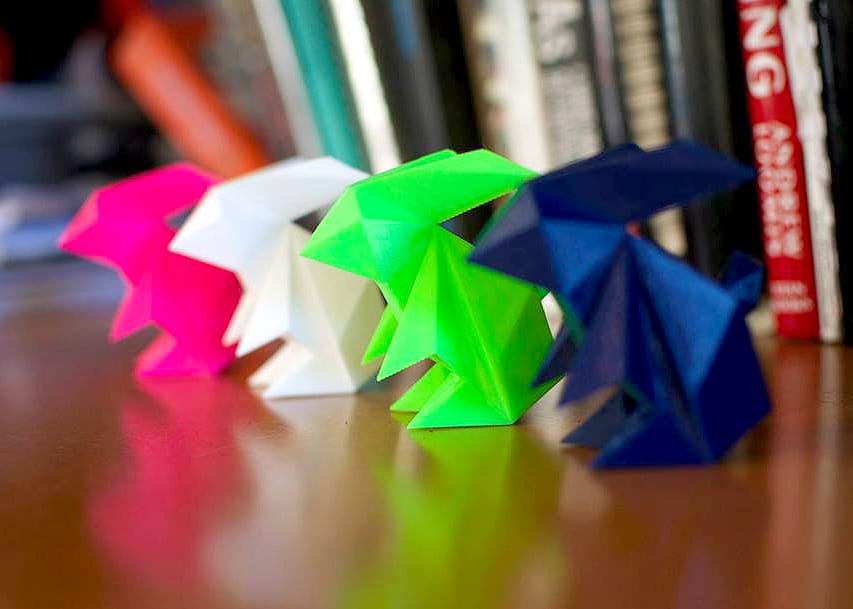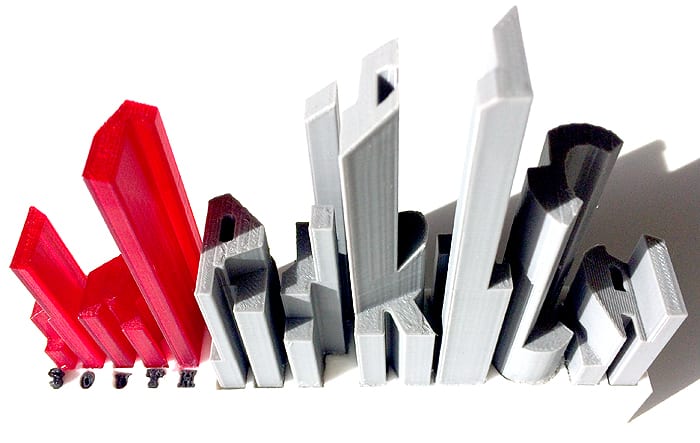ARTsouthAFRICA in conversation with Harry Ravelomanantsoa, MD and founder of Rabbit Digital Manufacturing Studio based in Cape Town, South Africa. This interview was published in full in The Innovation Issue (13.3) of ARTsouthAFRICA.

ABOVE: 3D-printed versions of Rabbit Digital Manufacturing Studio’s logo. Image courtesy of Rabbit.
ARTsouthAFRICA: You describe yourselves as ‘disruptively innovative’ – what does this mean to you, and how is it reflected in the kind of work that Rabbit does?
Harry Ravelomanantsoa: Disruptive Innovation is not a new term. It refers to a development that comes along and changes the way things are done. The Internet is a perfect example of disruptive innovation – it completely changed the way we do things, from commerce to sharing knowledge, it revolutionised the world. 3D printing has the same potential; it can completely change the way we do medicine, engineering, art, design and architecture.
It’s interesting that your brother and co- founder, Marc is an artist (Zoomak), and a technical director. Could you elaborate on the strong relationship between creativity and using additive manufacturing technology?
3D printing is the perfect example of using both the left brain and the right brain, you need them to work together to print a product using 3D printers. With the creative side, you can design and envision the product, and you need the technical side to make it a reality, to understand the machines and the possibilities and limitations thereof.
It’s also a question of “does form follow function or does function follow form?” You need to be able to use both the technical and the creative to work through this.
Up until fairly recently, 3D printing was a wonder reserved for the medical, manufacturing and engineering fields, but more and more we see artists exploring 3D printing in their work. You say on your website that, “Rapid Manufacturing is not an alternative to traditional methods but rather an additional medium to assist creative development.” What kind of opportunities does this remarkable technology provide for contemporary artists?
3D printing provides artists with a new kind of freedom, the freedom to experiment and produce prototypes without the time constraints. It also allows the artists freedom to explore different ways of producing art, of seeing and holding an object that they’ve had in their minds. It provides the opportunity to take a digital (virtual) work and create something you can hold, something with weight and mass and form.
Using this technology, 3D artist Cosmo Wenman managed to recreate ancient Greek statues Venus de Milo and the Winged Victory of Samothrace. The originals are both in The Louvre, but Wenman used a household 3D printer, at the cost of $5 a piece. What does this mean for the process of making art, and the value thereof? You describe 3D printing as “a progression of the arts;” how does this progression impact upon traditional methods of production?
I don’t think that we should alienate one method or the other, or compare them so flatly. 3D printing provides new avenues of production, a new way of making – not a replacement. We can’t replace materials. If you’re a sculptor who works with wood, or marble, or your hands – that’s not going to change. But as I said, it’s an additional medium, a different way of producing art. It takes creativity to produce the drawing, to envision it and bring it to life.
With regards to the ancient statues being reproduced, I think it’s great for museums around the world to be able to replicate an original artefact, acknowledge that it’s a replica and then put it in museums around the world for everyone to see. It’s like a musician making music and putting it online, everyone can listen, no matter where they are. It can be a great resource for that.
My brother coined the term ‘hybridation’ – where you combine different disciplines and mediums to create a completely new thing – and I think that this is a huge trend for creatives, creating art and 3D printing.
Do you have a personal favourite artist that uses 3D printing technology as their medium?
There are so many artists who inspire us, artists who are doing really great things. One of them is Michaella Janse van Vuuren, a South African artist who is making some amazingly creative and innovative 3D art. Janse Van Vuuren uses industrial printers, so her process is different from others involving ‘low-cost’ 3D printers, but she is another example of using the left and right brain simultaneously. She has a doctorate in electrical engineering but is also an artist, and she’s making a real name for herself.
Another one is Anouk Wipprecht, a Dutch artist who has made a 3D ‘spider’ dress and ran an electric current through it so that the spider’s legs moved with motion sensors. She also made a dress that ran an electric current through the models fingertips, which is an astounding display of the intersection of art and technology.
You have recently partnered with Wizardz, a leading print bureau in Cape Town to create a 3D printing, consulting and design pop-up boutique, effectively bringing 3D printing technology even closer to the public realm. Congratulations on this innovative partnership! What do you hope to see the public doing now that 3D printing is more accessible than ever? Do you think it will inspire a new generation of designers and artists who are drawn to create with this exciting medium?
I think that, at first, we just want people to come and see a 3D printer in action, to see the mechanics and the process. To bring that knowledge and experience to the public is a great opportunity. Most people don’t have the skills to design their own product, but there are websites like Honkiat, Thingiverse or Sculpteo, where you can download your product and it can be printed. We can also turn your idea into a 3D product – we help you through the process, model and design it for you – and you can have your product in a day or two, sometimes even a couple of hours. The idea of people having at-home 3D printers is still somewhat far- out, because people will still need the design knowledge to create, but this is definitely a start.
I think it is creating a new profession too; a new generation will be inspired by the technology and will want to learn the more technical programmes to be able to generate models. The leading companies, such as Autodesk, Makerbot and recently HP, are showing the way by creating software that everyone can use to create digital art.
Rabbit has also started a 3D printing school programme. It’s great that you are creating opportunities and allowing young people access to new technology to help them grow their skills. Could you tell me more about this?
We want to teach students the technology, so that they will be able to use it for model- building, designing and prototyping, amongst other things. Because of my background, we first approached animation schools, but we’re now partnering with engineering departments, medical and design schools to bring the technology to the students.
Students will be able to have access to 3D printers, a medium they wouldn’t normally be able to use. We offer students different levels of tuition, and charge different fees, based on their experience. First year students would only need one or two models a year, while a final year student could need up to ten. We discount our rates hugely to make it far more affordable, but also believe that we have to charge something, to impart the values of real-world experience and work ethic.
While there are some places that do it for free – the CCID is doing some great courses for free, for example – we offer them hugely discounted fees and then offer consulting and support free of charge.
The possibilities for this technology seem endless! What are you most excited about at the moment? What can we look forward to seeing from Rabbit in the near future?
At the moment I’m really happy that just one year ago we were sitting brainstorming all of the things we wanted to get involved with, and now we are working at all of them. We wanted to get into medical design, and we’re now making prosthetics, we’re also involved in fashion, design and engineering.
We’re a relatively small studio, so we’re looking to expand this year too! We’ve partnered with some really great companies and clients too, which we’ll be able to announce in the near future.
Looking outward, we’re following the development of 3D printing and space technology really closely – there are some amazing things happening! The International Space Station now has it’s own 3D printer, and they recently printed a spanner for astronauts to use in space. It costs anywhere between ten and sixty thousand dollars to launch 1kg (of material and tools) into space, but now they can send a printer up and are developing a method to use materials in-situ (from Mars and the Moon) to print equipment in space.
Imagine the jobs that will create too, for engineers and architects to be able to design products to be printed in space!
There are some incredible innovations and developments happening, and we’re really excited to be part of it all!

Rabbit 3D designed and printed the model of ARTsouthAFRICA’s logo which was used as a design element throughout The Innovation Issue (13.3).




